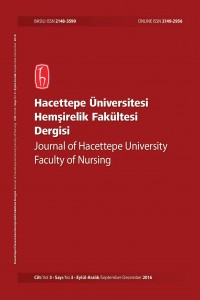Abstract
Bu araştırmada dâhiliye kliniğinde yatmakta olan bir tip II diyabet hastası olgu olarak sunulmuştur. Hastaya hemşirelik öğrencileri ve öğretim elemanları tarafından klinik uygulama sırasında Roper, Logan ve Tierney’in geliştirdiği günlük yaşam aktiviteleri modelinden yararlanılarak bütüncül yaklaşımla hemşirelik bakım planı uygulanmıştır. Olguda saptanan sorunlar; kan glikoz düzeyinin yüksek olması, deri bütünlüğünde bozulma ve ayak yarası riski, düşme riski, ağız içi hijyeninde bozulma, iştahsızlık ve sosyal ilişkilerin zayıf olmasıdır. Saptanan sorunlara yönelik ilaç kullanımı, beslenme, egzersiz, ayak bakımı, epilepsi ve düşme riski ile ilgili eğitim verilmiş, deri, ağız ve ayak bakımı uygulanmış ve sosyal ilişkilerini güçlendirmek amacıyla motive edilmiştir. Değerlendirme aşamasında hasta ve aile üyesinden eğitimlere yönelik olumlu geribildirimi alınmıştır. Ancak birey evde takip edilemediğinden eğitimler sonunda davranış gelişip gelişmediği bilinmemektedir. Tip II diyabet bakımı ve tedavisi için klinik ve birinci basamak sağlık ekibinin iletişim kurarak birlikte çalışması önerilir.
References
- 1. World Health Organization. Global status on noncommunicable diseases. 2014;[302 screens]. URL: http://www.who.int/nmh/publications/ncd-status-report-2014/en/. Dec 04, 2015.
- 2. International Diabetes Federation. IDF Diabetes atlas. 2013;[160 screens]. URL: https://www.idf.org/ sites/default/files/EN_6E_Atlas_Full_0.pdf. Dec 10, 2015.
- 3. Satman İ, Ömer B, Tütüncü Y, Kalaca Y, Gedik S, Dinççağ N, Karşıdağ K, Genç S, Telci A. Twelveyear trends in the prevalence and risk factors of diabetes and prediabetes in Turkish adults. Eur J Epidemiology 2013 28 (2):169-80.
- 4. American Diabetes Association. Hospital admission guidelines for diabetes. Diabetes Care 2004 27 (suppl 1):103.
- 5. Fişek N. Halk sağlığına giriş. Ankara: Çağ Matbaası; 1983. s. 26
- 6. Benton DC. Non-communicable diseases: a vertical or horizontal approach? International Nursing Review 2012 59(3):296.
- 7. Roper N, Logan WW, Tierney AJ. The Roper Logan Tierney model of nursing: Based on activities of living. Edinburg: Elsevier Health Sciences; 2000. s. 20
- 8. Onat A, Hergenç G, Uyarel H, Can G, Özhan H. Prevalance, incidence, predictors and outcome of type 2 diabetes in Turkey. Anadolu Kardiyol Derg 2006 6:314-21.
- 9. Türkiye Cumhuriyeti Sağlık Bakanlığı. Türkiye kronik hastalıklar ve risk faktörleri sıklığı çalışması. 2013;[353 screens]. URL: http://sbu.saglik.gov.tr/Ekutuphane/kitaplar/khrfat.pdf. Dec 04, 2015.
- 10. Acemoğlu H, Ertem M, Bahçeci M, Tuzcu A. Tip II diyabetes mellituslu hastaların sağlık hizmetlerinden yararlanma düzeyleri. EAJM 2006 38:89-95.
Abstract
In this study, a patient with type II diabetes who was hospitalized in an internal medicine clinic was presented as a case. During clinical practice, a holistic nursing care plan developed by utilization of Roper, Logan and Tierney’s Daily Living Activities Model was carried out with the patient by nursing students and their instructors. The problems determined in this case were; high blood glucose level, deterioration of skin integrity and risk of foot wound, risk of fall, deterioration of oral hygiene, loss of appetite, and poor social relations. In order to solve these problems, education were provided regarding drug use, nutrition, exercise, foot care, epilepsy and risk of fall; skin, oral and foot care was provided; and the patient was motivated for strengthening her social relations. In the stage of evaluation, a positive feedback regarding the education was received from the patient and the family member. However, as the patient was not followed up at home, it was not known whether or not the behavior was developed at the end of the education. It is suggested that clinical and primary care team should cooperate by communicating for the care and treatment of type II diabetes.
References
- 1. World Health Organization. Global status on noncommunicable diseases. 2014;[302 screens]. URL: http://www.who.int/nmh/publications/ncd-status-report-2014/en/. Dec 04, 2015.
- 2. International Diabetes Federation. IDF Diabetes atlas. 2013;[160 screens]. URL: https://www.idf.org/ sites/default/files/EN_6E_Atlas_Full_0.pdf. Dec 10, 2015.
- 3. Satman İ, Ömer B, Tütüncü Y, Kalaca Y, Gedik S, Dinççağ N, Karşıdağ K, Genç S, Telci A. Twelveyear trends in the prevalence and risk factors of diabetes and prediabetes in Turkish adults. Eur J Epidemiology 2013 28 (2):169-80.
- 4. American Diabetes Association. Hospital admission guidelines for diabetes. Diabetes Care 2004 27 (suppl 1):103.
- 5. Fişek N. Halk sağlığına giriş. Ankara: Çağ Matbaası; 1983. s. 26
- 6. Benton DC. Non-communicable diseases: a vertical or horizontal approach? International Nursing Review 2012 59(3):296.
- 7. Roper N, Logan WW, Tierney AJ. The Roper Logan Tierney model of nursing: Based on activities of living. Edinburg: Elsevier Health Sciences; 2000. s. 20
- 8. Onat A, Hergenç G, Uyarel H, Can G, Özhan H. Prevalance, incidence, predictors and outcome of type 2 diabetes in Turkey. Anadolu Kardiyol Derg 2006 6:314-21.
- 9. Türkiye Cumhuriyeti Sağlık Bakanlığı. Türkiye kronik hastalıklar ve risk faktörleri sıklığı çalışması. 2013;[353 screens]. URL: http://sbu.saglik.gov.tr/Ekutuphane/kitaplar/khrfat.pdf. Dec 04, 2015.
- 10. Acemoğlu H, Ertem M, Bahçeci M, Tuzcu A. Tip II diyabetes mellituslu hastaların sağlık hizmetlerinden yararlanma düzeyleri. EAJM 2006 38:89-95.
Details
| Journal Section | Articles |
|---|---|
| Authors | |
| Publication Date | December 23, 2016 |
| Submission Date | July 31, 2017 |
| Published in Issue | Year 2016 Volume: 3 Issue: 3 |

